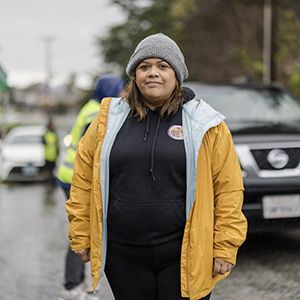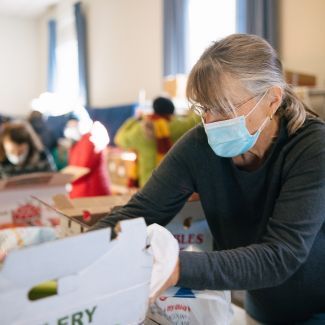
What’s happening?
Late last year, the outbreak of COVID-19 (coronavirus) was reported in China. Since then, the virus has spread across the globe, causing the World Health Organization to declare a pandemic . In the United States, there have been thousands of confirmed cases, with more than 100 deaths.
The virus has caused many school districts across the country to shut down and numerous states to declare emergencies, limit gatherings and institute tight social distancing rules as the number of cases continues to increase.
What are Feeding America and food banks doing?
COVID-19 is now in all 50 states, but so is Feeding America. Food banks across the country continue to mobilize their response to the pandemic, as they deploy new distributions, many of which are drive-through and outdoor, to maximize social distancing. The network is distributing emergency food boxes, and more will continue to reach families and individuals in need in the coming days and weeks. Meanwhile, other food banks are working with school districts and after-school programs to offer grab-and-go cold meals for children and families to help fill the gap while schools are closed.
---
Food banks across the network are packing and distributing emergency food boxes as more and more businesses and school districts close. Many food banks, such as Harvest Hope Food Bank in South Carolina, have also shifted their distribution models and are now offering drive-through options to limit person-to-person contact.
Additionally, food banks continue to work with school districts to fill the gap as children lose meals they'd normally be eating in the classroom. While these efforts take many different forms, food banks like the Atlanta Community Food Bank are distributing produce to schools on a weekly basis to ensure families have enough to eat at home. Many are also expanding backpack programs, adding mobile pantries at schools, and producing hot meals for children and their families.
---
Originally posted on March 13, 2020:
Feeding America’s top priority is the health and safety of the families and individuals we serve, as well as food bank staff and volunteers. As such, we are closely monitoring the coronavirus pandemic and are actively consulting with national disaster relief organizations and federal and local health departments. Feeding America is also working to secure additional federal food assistance for Americans who are low-income who could be more significantly impacted by the pandemic.
The Feeding America network of food banks continues to provide food to people struggling with hunger across the country.
One of the most significant impacts of the pandemic has been school closures. Without access to school meals, children lose
a consistent source of healthy food. As such, many food banks are distributing emergency food boxes at children's programs and in partnership with local school districts, as well as expanding capacity at existing children's programs. Many more are adding additional food distributions to help fill this gap. Food banks will continue to work with school districts and local government agencies to ensure children who rely on school meals have access to food outside of the classroom.
To address the larger immediate need created as businesses such as restaurants have reduced operations or shut down completely, many food banks have begun increasing the volume and frequency of food distributions. Many are also distributing emergency food boxes, have added mobile pantry stops and some are implementing drive-through food pickups and delivery options. Many of the food banks that prepare individual meals are increasing those efforts as well.
A task force of food banks and Feeding America staff is working together to provide support to the network. The task force is also preparing for potential adjustments in the distribution of food to minimize larger gatherings by deploying additional mobile pantries and making food distribution appointments, as opposed to open hours.
While it is still too early to determine the full economic effects of the coronavirus outbreak, Feeding America and its food banks are prepared to handle a potential increase in demand. And regardless of the reason for that need – be it a disaster, economic slowdown, or illness – we will continue to work to help people facing hunger have the food they need.
What can I do?
Feeding America has established a fund to support food banks. The COVID-19 Response Fund will help food banks across the country as they support communities impacted by the pandemic. The fund will enable food banks to secure the resources they need to efficiently serve the most vulnerable members of the community. Donate now to support those struggling with hunger in this time of crisis.
Additionally, Feeding America food banks continue to distribute food to people in need despite the coronavirus pandemic, and volunteers remain crucial to many food banks’ operations. If you’re scheduled to volunteer at a food bank, here are a couple of things you should do:
- If you’re sick or recovering from a fever, stay home! And when in doubt, stay home.
- If you need to stay home, notify the food bank that you need to cancel your shift.
- If it hasn’t been canceled and you’re not sick, make sure to show up!
- Follow the Centers for Disease Control and Prevention’s steps to prevent illness. In general, those include washing your hands often and avoiding touching your eyes, nose, and mouth with unwashed hands.
Food banks are trusted community resources and during this difficult time, as families and individuals figure out how they can stay safe and healthy, you can help too. Find your local food bank, and find out what is needed at the local level and support how you can.
Follow Feeding America on Facebook or X for up-to-the-moment information on how food banks across the country are responding to the COVID-19 pandemic.

